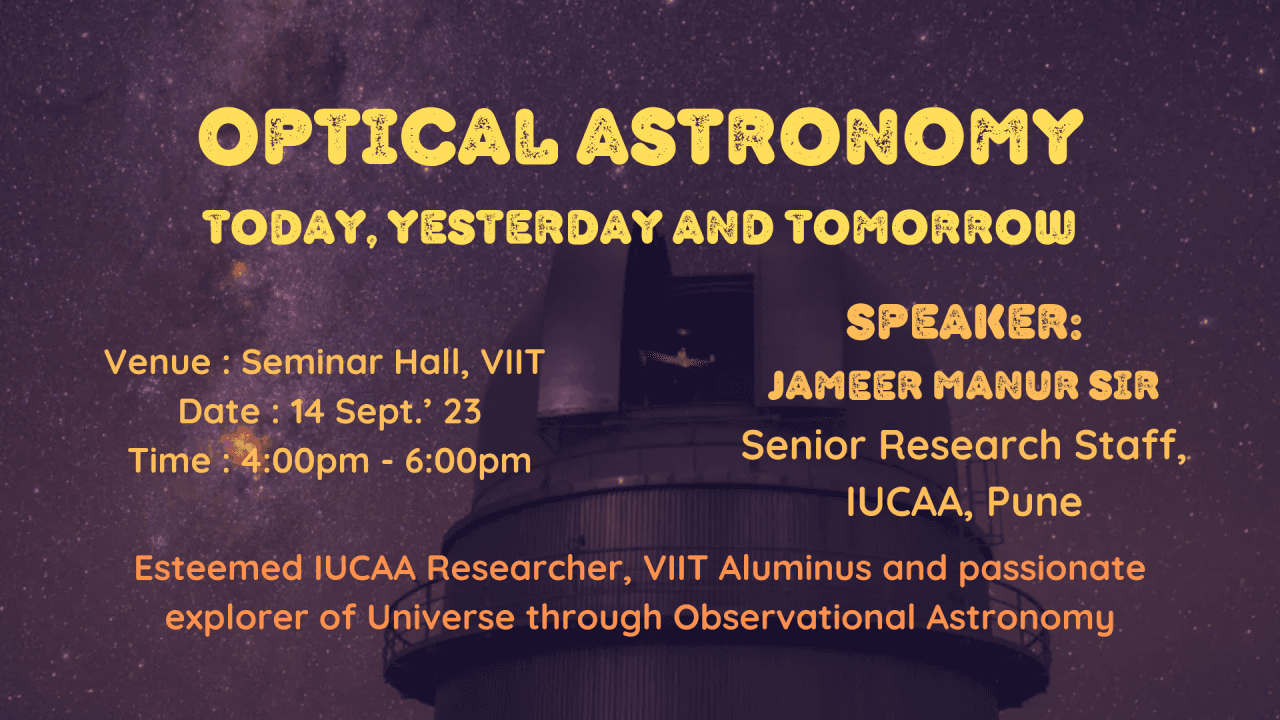Date: January 13, 2024
Venue: Room 1410, EnTC Department, Vishwakarma Institute of Technology (VIT), Pune
Organizer: Antariksh VI, Astronomy Club of VIT
Speaker: Bhavya Shah, Core Committee Member
Topic: History and Working of Optical Telescopes
Attendees: 22

---
Overview:
On the afternoon of January 13, 2024, the Antariksh Astronomy Club at Vishwakarma Institute of Technology hosted an in-depth internal talk titled "History and Working of Optical Telescopes," presented by core member Bhavya Shah. The session covered the evolution, mechanics, and types of optical telescopes used in both amateur and professional astronomy. With 22 participants in attendance, the discussion was well-received and included engaging content on the types, mounts, and optical characteristics that make telescopes effective tools for exploring the universe.
---
Key Highlights of the Session
1. Introduction to Optical Telescopes
- Definition: Bhavya Shah opened the session by defining optical telescopes as instruments designed to gather and magnify visible light from celestial objects, making them observable to the human eye or sensors.
- Need and Aim: He discussed the primary purpose of optical telescopes: to enable astronomers to study distant objects, revealing details that are otherwise invisible, thus contributing significantly to both amateur and professional astronomy.
2. Types of Optical Telescopes
- The speaker detailed three main types:
- Refractive Telescopes: Using lenses to bend light, these were the first telescopes developed.
- Reflective Telescopes: Utilizing mirrors to eliminate chromatic aberration.
- Compound (Catadioptric) Telescopes: Combining lenses and mirrors for versatile use in observation and photography.
3. Mounts of the Optical Telescope
- Dobsonian Mount:
- Advantages: Noted for its simplicity and robustness, particularly suitable for large telescopes at a lower cost. Ideal for stability, especially beneficial to amateur astronomers.
- Disadvantages: Lacks automatic tracking, requiring manual adjustments to keep objects centered.
- Equatorial Mount:
- Advantages: Essential for astrophotography due to its ability to track celestial objects precisely.
- Disadvantages: Requires polar alignment, making it more complex than altazimuth mounts, and needs periodic adjustments during long exposures.
4. Early Generations of Optical Telescopes
- Refractive Telescopes:
- Advantages: Known for high-quality images, especially useful at lower magnifications for planetary observations.
- Disadvantages: Prone to chromatic aberration, causing color fringing and blurred images.
- Galilean Telescope:
- Early telescope using a biconvex objective lens and a planoconcave eyepiece lens. Provided a narrow field of view with upright images.
- Keplerian Telescope:
- Employs two biconvex lenses, offering an inverted image. The telescope was highlighted for its historical significance and issues with chromatic aberration.
- Chromatic Aberration:
- Detailed explanation on how this affects images by not allowing all colors to converge at a single point, resulting in color fringing. Solution approaches, including the use of compound lenses, were also discussed.
5. Next-Generation Optical Telescopes
- Newtonian Telescopes:
- Advantages: Cost-effective and ideal for beginners, providing high-quality images for its price range.
- Disadvantages: Requires regular collimation, and images may suffer from coma and astigmatism at the field’s edges.
- Tilt-Mirrored (Schiefspiegler) Telescopes:
- Advantages: Provides a wide field of view and high-quality images.
- Disadvantages: Complex to build, requiring precise mirror alignment to avoid optical distortions.
- Geometric Aberrations:
- Explanation of how imperfections, like spherical aberration and coma, occur due to deviations from ideal light paths, leading to distortions. Solutions discussed included adjusting mirror curvature and employing corrective optics.
6. Compound (Catadioptric) Telescopes
- Schmidt-Cassegrain Telescopes:
- Detailed the history and benefits of catadioptric telescopes, combining lenses and mirrors. Discussed the Schmidt corrector plate's role in correcting spherical aberration.
- Advantages: Compact design with computerized tracking capabilities, making it suitable for both visual observation and astrophotography.
- Disadvantages: High cost and susceptibility to optical aberrations, like coma and field curvature, particularly at lower focal ratios.
7. Types of Telescope Mounts
- Altazimuth Mount:
- Explained as a simple, two-axis mount that moves horizontally and vertically. Suitable for general observations but limited for precise tracking.
- Equatorial Mount:
- Aligned with Earth’s axis, enabling smooth tracking of celestial objects. Noted for its effectiveness in astrophotography due to its ability to follow the rotation of the Earth.
- Importance of Mounts:
- Explained that mounts are critical for stability and tracking, allowing telescopes to capture detailed images over extended periods.
8. Important Telescope Models
- Catadioptric Telescopes (e.g., Schmidt-Cassegrain):
- Discussed as versatile models used widely by amateur astronomers due to their ability to perform in both visual and photographic capacities.
- Disadvantages: Complex optical systems that may require additional optical correction to maintain image quality.
- Schmidt-Cassegrain Telescope:
- Highlighted for its adaptability in different observational setups, widely popular due to its compact design and ease of use.
---

Conclusion
The session wrapped up after approximately one hour, providing participants with a solid understanding of the fundamental types, components, and design principles of optical telescopes, as well as the technological advancements over generations. Participants left with a comprehensive view of telescope evolution and its contribution to observational astronomy. The engaging presentation and interactive format made the talk both informative and enjoyable, equipping attendees with valuable insights into the science of optical telescopes.


